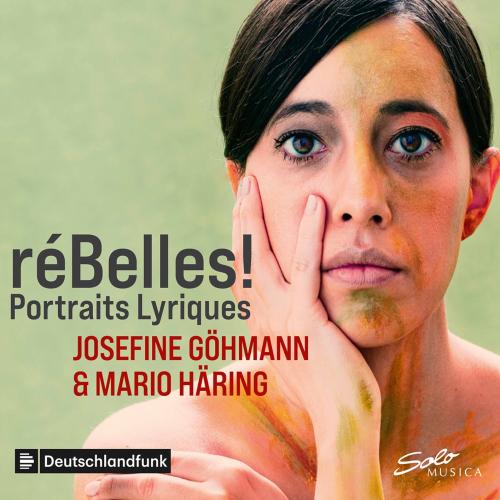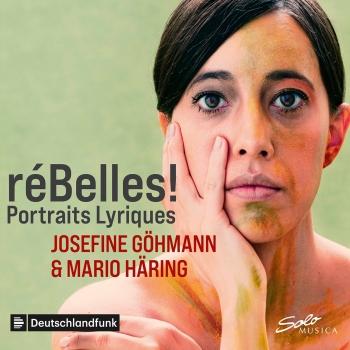
Rébelles!: Portraits lyriques Josefine Göhmann & Mario Häring
Album info
Album-Release:
2022
HRA-Release:
01.04.2022
Label: Solo Musica
Genre: Classical
Subgenre: Vocal
Artist: Josefine Göhmann & Mario Häring
Composer: Arnold Schoenberg (1874-1951), Arthur Honegger (1892-1955), Lili Boulanger (1893-1918), Paul Hindemith (1895-1963), Kurt Weill (1900-1950), Olivier Messiaen (1908-1992), Ernest Chausson (1855-1899), Richard Strauss (1864–1949), Wolfgang Rihm (1952)
Album including Album cover
- Feliz Anne Reyes Macahis (b. 1987): La vierge de Cluny "Chant d'une femme":
- 1 Macahis: La vierge de Cluny "Chant d'une femme" 07:38
- Arthur Honegger (1892 - 1955): Judith, H. 57b: Prière (Arr. for Soprano Voice & Piano)
- 2 Honegger: Judith, H. 57b: Prière (Arr. for Soprano Voice & Piano) 02:59
- Arnold Schoenberg (1874 - 1951): 4 Lieder, Op. 2:
- 3 Schoenberg: 4 Lieder, Op. 2: No. 2, Jesus bettelt 03:49
- Lili Boulanger (1893 – 1918): Clairières dans le ciel:
- 4 Boulanger: Clairières dans le ciel: No. 5, Au pied de mon lit (Arr. for Soprano Voice & Piano) 02:15
- Arthur Honegger (1892 - 1955): La tempête, H. 48:
- 5 Honegger: La tempête, H. 48: Chant d'Ariel (Arr. for Soprano Voice & Piano) 02:24
- 6 Honegger: 3 Chansons de "La petit sirène", H. 63 (Version for Voice & Piano): No. 1, Chanson des sirènes 01:30
- 7 Honegger: 3 Chansons de "La petit sirène", H. 63 (Version for Voice & Piano): No. 2, Berceuse de la sirène 01:08
- 8 Honegger: 3 Chansons de "La petit sirène", H. 63 (Version for Voice & Piano): No. 3, Chanson de la poire 00:27
- Paul Hindemith (1895 - 1963): 8 Lieder, Op. 18 (Excerpts):
- 9 Hindemith: 8 Lieder, Op. 18 (Excerpts): No. 1, Die trunkene Tänzerin 01:58
- 10 Hindemith: 8 Lieder, Op. 18 (Excerpts): No. 3, Traum 02:36
- Kurt Weill (1900 - 1950): Nanna's Lied:
- 11 Weill: Nanna's Lied 04:07
- Alexander Wagendristel (b. 1965): 4 Reden der Johanna Dark:
- 12 Wagendristel: 4 Reden der Johanna Dark: No. 2, Die Schaukel 03:37
- Kurt Weill: Marie Galante:
- 13 Weill: Marie Galante: Youkali (Arr. for Soprano Voice & Piano) 06:13
- Olivier Messiaen (1908 - 1992): Harawi, I/28 (Excerpts):
- 14 Messiaen: Harawi, I/28 (Excerpts): No. 1, La ville qui dormait, toi 01:59
- 15 Messiaen: Harawi, I/28 (Excerpts): No. 5, L'amour de Piroutcha 03:53
- Ernest Chausson (1855 - 1899): Chansons de Shakespeare, Op. 28:
- 16 Chausson: Chansons de Shakespeare, Op. 28: No. 3, Chanson d’Ophélie 01:42
- Richard Strauss (1864 - 1949): 6 Lieder, Op. 67, TrV 238 (Excerpts):
- 17 Strauss: 6 Lieder, Op. 67, TrV 238 (Excerpts): No. 1, Wie erkenn' ich mein Treulieb 02:37
- 18 Strauss: 6 Lieder, Op. 67, TrV 238 (Excerpts): No. 2, Guten Morgen, 's ist Sankt Valentinstag 01:18
- 19 Strauss: 6 Lieder, Op. 67, TrV 238 (Excerpts): No. 3, Sie trugen ihn auf der Bahre bloss 03:42
- Wolfgang Rihm (b. 1952): Ophelia Sings:
- 20 Rihm: Ophelia Sings: No. 1, How Should I Your True Love Know? 01:59
- 21 Rihm: Ophelia Sings: No. 2, Tomorrow is Saint Valentine's Day 01:50
- 22 Rihm: Ophelia Sings: No. 3, They Bore Him Bare-Faced on the Bier 03:38
- Aya Yoshida (b. 1971): Réquiem para un niño "Canción de cuna eterna":
- 23 Yoshida: Réquiem para un niño "Canción de cuna eterna" 05:31
Info for Rébelles!: Portraits lyriques
For the German-Chilean soprano Josefine Göhmann , diversity in subject and era forms the core of her artistic interest with a stylistic range from late Renaissance to Mozart, Strauss, Messiaen and contemporary music.
In a duo with pianist Mario Häring , Josefine Göhmann will present her debut album “reBELLES! portraits lyriques" on the subject of female self-determination and 100 years of the women's rights movement on the Solo Musica label. Deutschlandfunk is dedicating a music panorama and the program “Wortspiel” to the “reBELLES!” project, where the commissioned work “La Vierge de Cluny . Chant d'une femme” for soprano a capella is analytically presented by the Filipino composer Feliz Anne Reyes Macahis (*1987).
When planning this program, the artist used postcards from museum visits as a guide: the paintings say a lot about how women were seen in the 20th century and how women in self-portraits (e.g. by Frida Kahlo, Paula Modersohn-Becker, Anita Rée) have seen for themselves. She developed the idea that if song and painting are set analogously, the album could correspond to a visit to a museum. There are four different rooms. The first is Vierge with depictions of virginity in the context of the biblical testament. Then there is the second room for the Sirène type of woman, in which the more ethereal femininity is depicted. In Héroïne, women are primarily portrayed as heroines. And finally Ophélie devotes herself to the literary Shakespearean character who stands for himself,
This album is an aesthetic proposal for the discourse on femininity, on being a woman today and for a hundred years. The artist's very personal feelings also play a role in determining which pieces are combined and how. Josefine Göhmann not only wanted to look at texts, works and interpretations by women, but also at our cultural heritage. There is nothing wrong with only looking for works by women. She finds every discovery of a composer and approaches to her music very important. But that wasn't her idea at réBelles. This album is the mirror of what she likes and loves and what she feels fits together.
Josefine Göhmann, soprano
Mario Häring, piano
No biography found.
This album contains no booklet.









